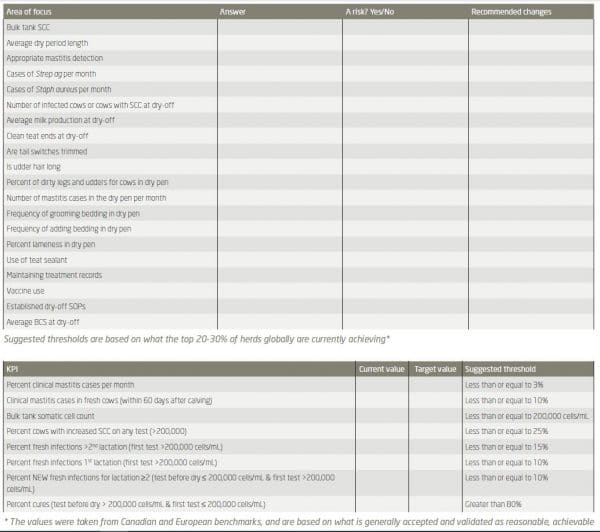Until now, there are no internationally established guidelines for successful drying-off and dry period for dairy cows. European experts have agreed on a common approach to promote a healthy dry period by curing existing and avoiding new intramammary infections (IMI) while considering prudent use of antimicrobials.

In late 2019, DeLaval invited selected European experts to Hamra Farm in Sweden, to discuss drying-off strategies. During the meeting, the participants shared their expertise and discussed differences in farm management and practical recommendation between countries. Based on this input, a new guideline for a successful dry period was initiated.
Management around the dry period is a component of an effective mastitis control program. Maintaining properly functioning milking equipment, dipping teats at the end of the milking procedures and keeping accurate and consistent records of mastitis (including somatic cell count, SCC) as well as treatment decisions are all important measures during lactation. Additionally, a thorough udder and overall health program, including trimming tails, flaming udders, trimming feet, application of parasiticides and maintaining an acceptable body condition score (BCS) is equally important.
Guidelines for successful dry period for dairy cows:
This guideline is divided into recommendations at three different stages:
- Approaching dry-off (within two months of dry-off day)
- Day of dry-off
- After dry-off (in dry pen)
Approaching dry-off (within two months):
- Confirm days carried calf for each cow to be dried.
- Assess the overall prevalence of infections on the farm.
Identify what pathogens are present.
Note the number of cases of clinical and/or subclinical mastitis. - Address milk production. Are levels appropriate for cessation of milking? The National Mastitis Council recommends a threshold of 15kg milk/day.
This may mean changing the feed ration for a short period.
This may mean changing milking frequency until day of dry-off (“gradual cessation”).
The farm may have separate pens to facilitate these changes. - Identify cows/quarters that currently have IMIs or will be at high risk for IMIs during the dry period.
Tools that can be used include individual SCC, mastitis records, sensors, molecular methods and culture.
This practice promotes prudent use of antimicrobials by allowing for determination of healthy cows and by only treating those deemed “not healthy”. This is the principle of “Selective Dry Cow Therapy” (see below).
Target optimal BCS for drying-off (you may need to adjust nutrition of lactating cows on herd level to meet your goal). - Monitor practices, review data, and set goals for the farm.

On day of dry-off
- Stop milking cows.
- Address cows/quarters with current IMIs and/or those at high risk for infection. This could mean:
1. Treatment with an intramammary antimicrobial.This may be limited to non-organic farms.
- Only approved, non-expired, commercial antibiotic products formulated for dry cow therapy in single-dose intramammary infusions should be used.
- This may be dependent on country-specific regulations.Some countries need confirmation of infection prior to antimicrobial use.
- Some countries only allow for use of certain classes of antimicrobials.
2. Culling of these cows when convenient, appropriate, or allowed.Chronic cows.
- Cows positive for specific pathogens.
- Cows with severely injured/malformed teat ends.
3. Close monitoring of high risk cows after calving.Consider the herd-level use of sealants, with the intention of sealing the teat end during keratin plug formation.
- Internal teat sealants are commercially available.
1. External teat sealants are commercially available.
2. Clean teats thoroughly before application or insertion of products, focusing closely on removal of manure from- and disinfection of- the teat end if using antimicrobials and/or teat sealant. - If using these products, follow manufacturer and veterinarian instructions. Store any unused product appropriately.
- Maintain accurate and consistent records of treatments.
- Place cows in a separate pen from lactating animals on a non-lactating ration.
- If applicable, train personnel on dry-off day Standard Operating Procedures (SOPs).
- Monitor practices, review data, and set goals for the farm.
In Dry Pen
- Upon recommendations from the veterinarian and/or qualified nutritionist, the farm should feed rations to decrease metabolic impacts and to promote immune function.
- Maintain optimal pen hygieneGroom the pen at least twice per day.
- Score the cows on cleanliness to determine any change needed.
- Add or replace bedding regularly.Frequency may be dependent on cleanliness scores.
- Ensure there is a dry place for animals to rest with plenty of bedding.
- Animals on pasture should be limited to non-muddy areas away from ponds.
- Assure appropriate stocking density.At least one stall per cow should be provided.
- In a bedded pack, each cow should be provided an area of at least 11m2.
- Provide adequate ventilation.
- Maintain mattresses, stalls, and gates.Stalls and pens should be the proper size to accommodate cows.
- Fix or replace any broken parts.
- Reduce pen moves. If necessary, move cows in groups rather than as individuals, though abilities may be herd specific.
- Monitor for clinical mastitis by visually inspecting udders at least once per day.
- Consider use of vaccines that target pathogens present on farm.Follow product label recommendations, with guidance by herd veterinarian.
- Current vaccines available include those targeting mastitis caused by Streptococcus uberis, Escherichia coli and Staphylococcus aureus.
- Monitor practices, review data and set goals for the farm.
Work with your herds to identify areas of improvement for a successful dry period by filling out the table below. This will assess risks associated with management practices around dry-off. A farm with minimal risks and good dry period management practices is a farm that may benefit from selective dry cow therapy.
Source: M2-Magazine




